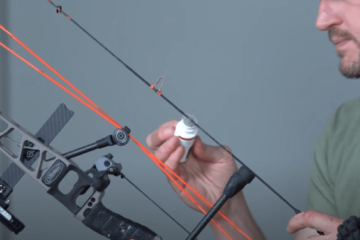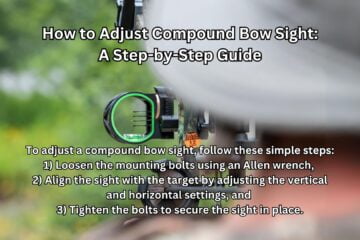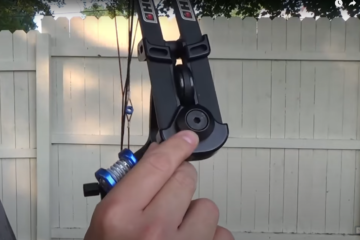To adjust draw weight on a compound bow, locate the bow’s limb bolts and use an allen wrench to tighten or loosen them as needed. Adjustable draw weights typically range from 5 to 10 pounds, so be sure to make small adjustments and test the bow’s draw weight after each adjustment.
A compound bow is one of the most advanced types of bows in modern archery. It is made of several systems and components, including the riser, limbs, and cam wheels. The cam wheels and limbs are connected by limb bolts, and these bolts can be tightened or loosened to increase or decrease the bow’s draw weight.
Adjusting the draw weight of your compound bow is necessary if you change draw lengths or move to a different bow setup. In this article, we will discuss how to adjust draw weight on a compound bow in detail.
Decoding Compound Bow Draw Weight
Compound bow draw weight refers to the amount of force required to pull the bowstring back to its full length. Measured in pounds, draw weight is an essential factor in selecting the right bow for a shooter. It defines the bow’s power and determines the force exerted on the arrow when released.
With the wrong draw weight, a shooter’s accuracy and performance can drastically suffer. That’s why adjusting the draw weight is essential. There are different factors to consider when adjusting draw weight, including individual archer’s strength, skill level, and preferred draw weight.
Other factors such as arrow type, intended purpose, and shooting style can also affect draw weight. By adjusting it to fit your needs, you’ll maximize your accuracy and comfort, and shoot with confidence.
Choosing The Right Draw Weight
When adjusting draw weight on your compound bow, carefully consider the right weight to choose. Assess your needs and determine which application you’ll be using the bow for. Then, take the correct method to measure your draw length and choose a weight within your range.
Common draw weight ranges vary based on the bow and individual needs. Different applications also require different draw weights. For hunting, choosing a draw weight depends on the animal being hunted and your own physical capabilities. Make an informed decision when choosing the right draw weight for you and your compound bow.
How To Adjust Compound Bow Draw Weight
Adjusting the draw weight on a compound bow is a crucial aspect of archery. Understanding your bow’s draw weight settings is the first step in the process. You can adjust draw weight through the bow’s settings or by using the draw weight adjustment method for cam and limb compound bows.
For limb bows, you may need to adjust the pre-set screw. If you’re unsure, seek professional assistance before attempting to adjust the draw weight on your compound bow. Keep in mind that the draw weight affects the velocity and accuracy of your arrows, so it’s important to get it just right.
Follow these steps carefully, and you’ll be on your way to perfecting your aim and achieving your archery goals.
Tips For Mastering Compound Bow Draw Weight
Mastering compound bow draw weight is a crucial aspect of being a successful archer. Understanding your limits is the first step. Exercises to enhance your technique can significantly improve your draw weight. It’s important to maintain your compound bow by keeping it clean and lubricated.
Fine-tuning your draw weight can make a big difference in your accuracy. If you will be hunting in extreme temperatures, make necessary adjustments to your draw weight to avoid issues. By following these tips, you can easily learn how to adjust draw weight on your compound bow and take your archery game to the next level.
Frequently Asked Questions Of How To Adjust Draw Weight On A Compound Bow
How Do I Adjust The Draw Weight On My Compound Bow?
To adjust the draw weight, you can either tighten or loosen the limb bolts using an allen wrench. Turn the bolt clockwise to increase the weight and counterclockwise to decrease the weight. Make small adjustments and test the bow until you find the desired weight.
Is It Necessary To Adjust The Draw Weight On My Compound Bow?
Yes, adjusting the draw weight can significantly improve your accuracy and comfort while shooting. It’s essential to have a draw weight that matches your strength and skill level. When the draw weight is too heavy or too light, it can affect your accuracy and cause fatigue or injury.
What Is The Ideal Draw Weight For A Compound Bow?
The ideal draw weight largely depends on the individual’s physical fitness and archery experience. However, most archers go for a draw weight between 50-70 pounds. It’s essential to choose a draw weight that you can comfortably manage without causing fatigue or injury.
How Do I Know If My Draw Weight Is Too Heavy?
If you struggle to hold your bow steady or feel fatigued after only a few shots, your draw weight may be too heavy for you. Additionally, if your arrows tend to fly to the left or right, it might be because your draw weight is too heavy for you to maintain a good form.
How Often Should I Check And Adjust My Draw Weight?
It’s crucial to check your draw weight regularly, particularly if you’re using your bow for hunting or competitive shooting. Make necessary adjustments maybe once or twice a year to ensure that your bow is performing optimally. Remember, holding a bow with the wrong draw weight can affect your shooting performance, so it’s crucial to make any necessary changes.
Conclusion
As you can see, adjusting draw weight on a compound bow can greatly improve your accuracy and overall experience as an archer. It’s important to have a basic understanding of your bow’s specifications, as well as the various techniques for adjusting the weight.
Remember to always make small adjustments and test your bow before making any major changes. Safety should always be a top priority, and if you’re unsure about any adjustments, don’t hesitate to consult a professional. By following these steps, you’ll be able to fine-tune your bow to your exact needs and preferences.
So, get out there and start practicing – happy shooting!





